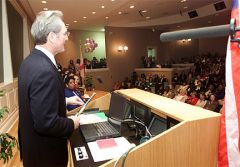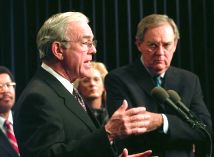|
Week of April 1, 2002 Blockbuster Deal of the Week from Site Selection's exclusive New Plant database |
|
LOOKING FOR A PREVIOUS STORY? CHECK THE ARCHIVE.
Hyundai's $1B Plant Alabama Bound After 11th-Hour Bargaining
By JACK LYNE, Site Selection Executive Editor of Interactive Publishing
SEOUL – The final brake shoe has dropped, and "Project Beach" has landed: Hyundai Motor Co., South Korea's largest carmaker, has picked Hope Hull, Ala., as the site of its new US$1 billion auto assembly plant. Located just south of Montgomery, the plant will employ at least 2,000 workers with annual average salaries of some $40,000.
The Alabama facility will be Hyundai's first U.S. plant. The site-selection announcement ends the often very public odyssey of Project Beach, the Seoul-based automaker's code name for its U.S. location search. Hyundai's operation marks the fourth major automotive production plant that Alabama has landed in nine years. "This is the biggest economic development project in the history of Alabama," said Gov. Don Siegelman. "We have once again shown the world that Alabama is simply a great place to do business." The Montgomery location won out over a site near Glendale, Ky. Hyundai in late February dropped sites in Mississippi and Ohio from its location shortlist. The Alabama announcement came at an April 2 press conference in Seoul. Smoothing U.S. trade relations and cutting currency risks were two parts of the Alabama site-selection rationale, explained Hyundai Motor Chief Executive Kim Dong-jin. "This is part of Hyundai's plan to become the world's fifth-largest carmaker by 2010," Kim said. "We wanted to reduce trade frictions with the United States and risks stemming from foreign exchange fluctuations." A number of other factors, though, drove this deal. Hyundai's negotiations with Alabama and Kentucky officials, in fact, continued almost to the point at which the automaker made its pick public. And those negotiations were apparently decidedly intense. Here's a look at how some of the issues played out in Hyundai's final decision. Incentives: 'Very Tough Negotiations' Incentives: Hyundai set the stage for serious bidding when it publicly announced that competition had narrowed to the Alabama and Kentucky sites. Both states first put themselves on the auto-industry map through generous incentives: Kentucky offered incentives of $125 million in 1985 in successfully landing Toyota's plant in Georgetown, Ky. Alabama's move came later, in 1993 when it offered a $253 million incentive package in luring a Mercedes plant to Vance, Ala.On paper, at least, the two states finished virtually even in the Hyundai incentives sweepstakes: Alabama on March 21 approved a $118.5 million incentive package. Kentucky's incentives came later, only gaining legislative approval on April 1, but they were slightly larger, totaling $123 million. Some points of contention in project negotiations remain cloudy.
"It's been some tough negotiation. It's been very tough," Kentucky Gov. Paul Patton said at a press conference the night Hyundai announced its pick. Those negotiations continued, said Patton, until only hours before the Alabama announcement in Seoul. And on some negotiating points, the automaker and the governor were definitely at loggerheads. "We insisted on protecting the interest of the commonwealth," Patton said. "There were certain things in the agreement we didn't agree with, that we simply could not do." Patton at the time declined to describe the points of contention, as did Hyundai officials. Kim, however, did note that Alabama "was very devoted by offering us various tax benefits."
The Kentucky governor added some clarity the next day. Hyundai and Kentucky's differences weren't over financial incentives, he explained. Kentucky, for example, wanted construction designs completed by May 15, while Hyundai wanted a Sept. 15 deadline, Patton said. Hyundai will tap cash reserves for 70 percent of the $1 billion plant investment, Kim said, with the remaining 30 percent financed in the United States. Alabama Wins Race in "The city was very supportive, [and] the county was very supportive in putting the land together quickly," Siegelman said. Kentucky's site acquisition proved a far rockier road, the biggest boulder being Norma Howlett and son Paul. After the Howletts balked at selling their 111-acre (44.4-hectare) parcel, Hardin County officials began eminent domain proceedings. Soon, though, it became apparent that those proceedings were going to take too long. Finally, the state at 4 p.m. EST on April 1 reached an agreement with the Howletts for a $6 million purchase option on land initially appraised at between $800,000 and $900,000. The state had spent $17.3 million in optioning the entire other 1,500 acres (600 hectares) offered Hyundai, Patton said. "They were basically successful, except they killed the goose before it had time to lay the golden egg," said the governor. (The Howlett family has refused public comment on the issue.) Resolving the site-availability issue so late in the game damaged Kentucky's cause, as did the negative publicity glut that the land spat generated. Kim specifically mentioned the dustup at his press conference. Kentucky will still buy the 1,500 optioned acres, securing the large site for future location prospects, Patton said. But the Howlett land, he added, won't be part of the site. Kim: Alabama 'Far More Enthusiastic' The DaimlerChrysler factor: The Mercedes plant in Vance helped Alabama's cause with Hyundai, some industry observers maintained. DaimlerChrysler (DC) owns a 10 percent stake in Hyundai. And Kim in his press conference said that Hyundai was in talks with DC about creating an auto-production joint venture.The DC-Hyundai site-selection connection, however, may turn out to be a mirage. The day after the Alabama site announcement, Mitsubishi CEO Rolf Eckrodt claimed that DC was going to scrap its strategic alliance with Hyundai in favor of a focused Asian partnership with Mitsubishi. Market proximity: Which state had the edge here is slippery stuff. The Alabama site's port proximity was a significant factor in its favor, Kim said. Montgomery lies some 175 miles (280 km.) from the Port of Mobile on the Gulf of Mexico. The Mobile port would certainly be a major plus if Hyundai plans to ship its Alabama-made vehicles to Central or South America. On the other hand, if the Korean automaker plans to market its Alabama-made product in the eastern half of the United States, Kentucky is considered the more central location. Hyundai, however, hasn't divulged where its U.S.-made vehicles will be sold. The company has said only that the Alabama plant's output will rise to 300,000 vehicles annually. In addition, those vehicles will be unique to the Montgomery plant, Kim explained. "We have been developing new mid-sized sedans and sports utility vehicles, which will be produced only in the Alabama plant," he said. Labor, transportation, utilities and "temperature": Most location analysts considered the two sites roughly even in terms of labor, transportation and utilities. Kim, however, gave the clear edge to Alabama. In an unusually strongly worded comparison of the two contenders, Hyundai's chief executive even mentioned average temperatures - which most observers had never considered a location factor. "The state government of Alabama has shown a far more enthusiastic attitude towards luring Hyundai's auto-plant investments than its Kentucky counterpart," Kim said. "In addition, Alabama proved superior to Kentucky in terms of transportation, utility infrastructures, labor quality and costs, and temperature. "By contrast, the Kentucky government has failed to condemn parts of the candidate site for the Hyundai plant, due to a pricing dispute with the land owners," he said.
Editor's Note: For insights into the conditions that laid the groundwork for this blockbuster deal, see "Talent and Teamwork Help Alabama Reach Critical Mass," our roundtable discussion featuring key individuals in state economic development and industry. The article is on p. 380 in the May issue of Site Selection.
©2002 Conway Data, Inc. All rights reserved. Data is from many sources and is not warranted to be accurate or current.
|


